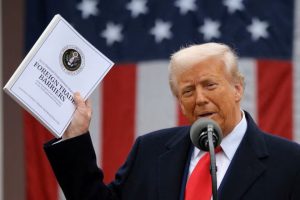President Donald Trump on Wednesday announced plans that would take the U.S. trade duties beyond their 1930s levels.
Back then, the infamous anti-import Smoot-Hawley Tariff Act deepened a global economic slump and helped send the Dow Jones Industrial Average (.DJI), opens new tab down over 30%, opens new tab in a year.
Yet investors are so far taking a different view this time around, with markets slipping by just a few percentage points on Thursday. There’s ample scope for things to get worse.
In Europe, which faces a 20% levy under Trump’s so-called reciprocal tariff plan, the benchmark STOXX 600 Index (.STOXX), opens new tab was down just 2%.
And it’s not because all the bad news was priced in previously. Before Wednesday’s announcement in the White House Rose Garden, European stocks were trading at more than 14 times 12-month forward earnings, which is comfortably above their two-year average of around 13, according to LSEG data.
Japan’s TOPIX Index (.TOPX), opens new tab was the hardest hit of the major Asian indexes, but still only closed 3% lower, similar to the decline implied by U.S. equity futures before Thursday’s opening bell.
RELATED: Donald Trump faces revised US indictment in election subversion case
Nor are credit markets panicking. The iTraxx Crossover Index of European credit default swaps tied to junk-rated debt, a proxy for the risk of corporate failures, jumped on Thursday but is still well below peak 2023 levels.
The U.S. dollar’s selloff was also counterintuitive. An index of its value versus trading partners’ currencies fell 2%. Investors generally expect the greenback to strengthen after major U.S. tariffs.
It helps that central banks are loosening policy. Interest-rate traders are now baking in a 90% chance of the European Central Bank cutting rates in April, LSEG data shows.
Governments, especially Germany and China, were already preparing fiscal stimulus packages, which could also ease the economic hit.
The key explanation for markets’ minimal reaction, though, is that investors think Trump’s plans won’t become a lasting reality. He showed signs on Wednesday that other countries could reduce their duties through negotiations.

Europe and China fought back with words on Thursday but didn’t materially escalate. The president may also meet domestic resistance to a plan which UBS economists reckon could shave several percentage points off U.S. GDP growth in a worst-case scenario, while also stoking inflation.
Yet negotiations are unlikely to be smooth, and the White House pledged to impose many of the duties within days.
To create some leverage over Trump, trade partners like Europe may find it necessary to retaliate before sitting down at the bargaining table, for example by hitting U.S. service exports.
If deals can’t be struck, full-on trade wars could quickly follow, and countries that previously exported to the United States may try to dump produce in other markets.
UBS economists reckon global GDP growth could fall by 2 percentage points after widespread retaliation. In that scenario, echoes of the 1930s may start to ring louder.
Follow @Unmack1, opens new tab on X
CONTEXT NEWS
European Commission President Ursula von der Leyen on April 3 described U.S. President Donald Trump’s so-called reciprocal tariffs as a major blow to the world economy.
She said the European Union was prepared to respond with countermeasures if talks with Washington failed.
China urged the United States to immediately cancel its planned duties and vowed countermeasures to safeguard its own interests.
RELATED: Could Kamala Harris beat Donald Trump in November’s presidential race?
The U.S. move disregards the balance of interests reached in multilateral trade negotiations over the years and the fact that it has long benefited greatly from international trade, the Chinese commerce ministry said in a statement.
U.S. President Donald Trump said on April 2 that the United States would impose a 10% baseline tariff on all imports and higher rates on many of the country’s biggest trading partners, including 34% on China and 20% on the European Union.
The baseline 10% tariff is set to take effect on April 5, according to a subsequent statement from the White House, and the higher rates will start on April 9.
As of 0935 GMT on April 3, the STOXX Europe 600 Index was down 1.6%. Japan’s TOPIX Index fell 3% on the same day, while the key benchmark for Vietnam was down 6.7%.
Hong Kong’s Hang Seng Index fell 1.5%, while the Indian BSE Sensex was down 0.4% mid-afternoon in Mumbai.
The U.S. dollar index, which measures the currency’s strength against those of its key trading partners, was down about 1.7% compared with its levels just before Trump laid out his tariff plans on April 2.



